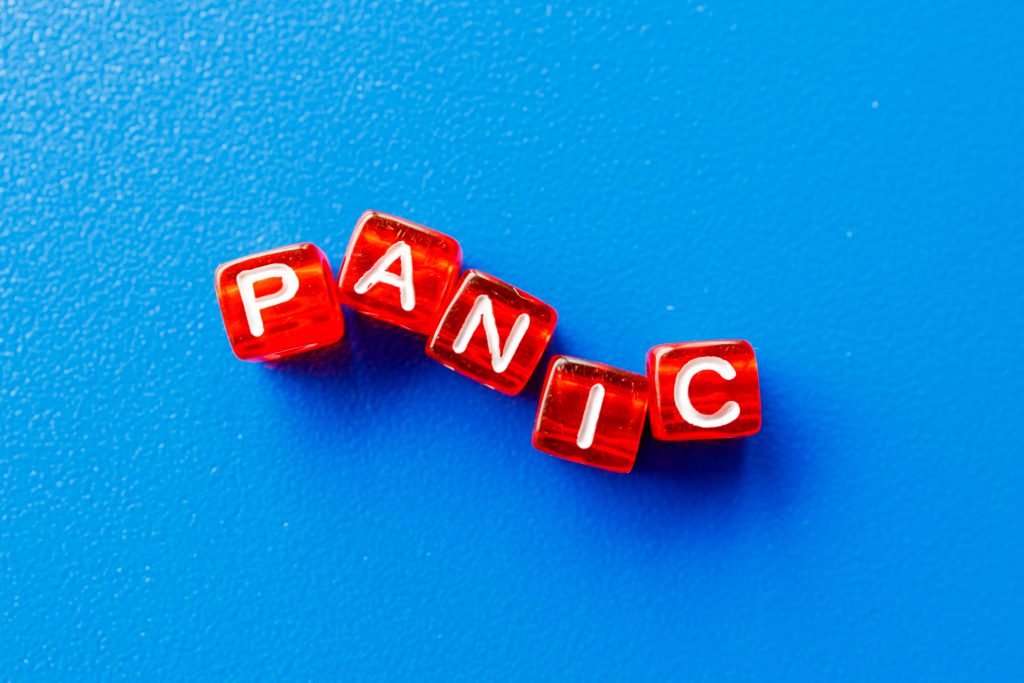
Cognitive-behavioural therapy (CBT) is the most effective psychological treatment for panic disorder (Papola et al., 2022), and is partially based on Clark’s (1996) cognitive model of panic disorder. This model proposes that panic attacks are the result of catastrophic misinterpretation of bodily sensations (e.g., interpreting a raised heartrate as a heart attack), which then snowballs (i.e., increased anxiety levels, heartrate quickening) and subsequently strengthens the initial catastrophic belief. This thinking creates a cycle, maintained by safety behaviours. CBT for panic disorder works to challenge the beliefs and behaviours described by Clark, and to break the cycle of catastrophic misinterpretation maintained by safety behaviours.
However, a big issue across psychological therapies is accessibility. The most frequent barriers to treatment delivery includes things like:
- Geographical barriers, with people from rural areas having longer commutes to treatment (Webb, Rosso and Rauch, 2017)
- Full-time workers with day-time commitments that prevent them from attending therapy during typical hours
- Patients with comorbid agoraphobia struggling to leave the house, and therefore not attending treatment (Newman et al., 2011).
Therapy delivered online and over the telephone can overcome these barriers, with these methods having additional flexibility. The recent COVID-19 pandemic has increased momentum for implementing alternative delivery formats for therapy, with most therapists working remotely during this time (Chevance et al., 2020). However, the question remains: are alternative delivery formats of CBT for panic disorder as effective as face-to-face delivery?
Previous studies have investigated this question in relation to CBT delivery formats for depression and anxiety, but Papola et al. (2023) is the first to do a head-to-head comparison of the effectiveness of CBT delivery formats for panic disorder.

Alternative CBT delivery formats can increase access to psychological treatments for people who would struggle to attend face-to-face therapy, but are these remote delivery formats as effective?
Methods
Papola and colleagues conducted a network meta-analysis of randomised control trials (RCTs) with the aim of evaluating “the comparative efficacy and acceptability of all CBT delivery formats to treat panic disorder”.
Five research databases were searched from database inception to 1st January 2022, to identify RCTs examining the effects of psychotherapy for panic disorder, compared with any other psychotherapy or control conditions.
The inclusion criteria were:
- Adults with a primary diagnosis of panic disorder, with or without agoraphobia
- CBT as the psychotherapeutic intervention
- Delivered by a therapist or as self-help.
The outcomes measured were efficacy in reducing panic symptoms, and the proportion of participants who discontinued from the trial. A series of pairwise meta-analyses for all direct comparisons was conducted using a random effects-pooling model.
Confidence in the evidence was assessed using Confidence in Network Meta Analysis (CINeMA). None of the comparisons were rated as high confidence, mainly due to within-study bias.
Results
Study characteristics
After screening was complete, 74 studies including 6,699 participants were included. The mean age of participants was 37.3 years, with 69.4% being women and the majority (77.6%) having agoraphobia. Only 56 of the 74 studies were eligible for the network meta-analysis.
The researchers used Clark and Salkovskis (2009)’s definition of CBT for their paper: “a treatment that focuses on patients’ interoceptive fears and uses both cognitive restructuring and behavioural procedures to reduce those fears”. Participants were randomised to receive CBT in four different delivery formats:
- Face-to-face individual
- Face-to-face group
- Guided self-help
- Unguided self help.
The table below shows the percentage of RCTs included in the analysis that had a certain number (N) of sessions/modules:
| N sessions/modules | % studies |
| 1-6 | 20.3 |
| 7-12 | 60.8 |
| 13-19 | 16.2 |
| Unclear | 2.7 |
Most participants (91.9%) were receiving medications during the treatment period.
Efficacy outcomes (n = 56)
- Group (moderate study confidence), individual (moderate study confidence) and guided self-help (low study confidence) CBT were superior to treatment as usual and waitlist in relieving the symptoms of panic disorder.
- Unguided self-help was not superior to treatment as usual.
The standardised mean difference (SMD) and 95% confidence intervals (CI) of efficacy between groups were:
- Group CBT vs. treatment as usual: -0.47 (-0.87 to -0.07)
- Group CBT vs. waiting list: -1.13 (-1.42 to -0.84)
- Individual CBT vs treatment as usual: -0.43 (-0.70 to -0.15)
- Individual CBT vs waiting list: -1.08 (-1.30 to -0.87)
- Guided self-help vs treatment as usual: -0.42 (-0.77 to -0.07)
- Guided self-help vs. waiting list: -1.08 (-1.33 to -0.83)
- Unguided self-help vs. treatment as usual: -0.21 (-0.58 to 0.16)
- Unguided self-help vs. waiting list: -0.87 (-1.14 to -0.60)
There were no significant differences in terms of efficacy between group, individual, guided self-help, and unguided self-help CBT.
Acceptability outcomes (n = 51)
No significant differences were found between different delivery formats, between delivery formats and comparators, and between comparators for the acceptability outcome.

According to this review, face to face (individual and group) and guided self-help delivery formats of CBT for panic disorder do not significantly differ from each other in terms of efficacy, but are all superior to treatment as usual or waitlist controls.
Conclusions
The authors concluded that:
There are no significant differences in terms of efficacy or acceptability when CBT is delivered via the face-to-face group, face-to-face individual, or guided self-help format, indicating that the three treatment formats are equally more effective over treatment as usual.
Unguided self-help, on the other hand, was not significantly better than waitlist controls, suggesting that CBT delivered in this format may not be as suitable for those with panic disorder and should not be recommended.

Other than unguided self-help (which was inferior), there were no significant differences in treatment efficacy based on delivery format. This means that more accessible delivery formats are not necessarily detrimental to treatment quality.
Strengths and limitations
One strength of this paper is that it is the first of its kind to compare alternative delivery formats on a common metric for a specific anxiety disorder. Taking advantage of all direct and indirect comparisons at the same time meant that the estimates were more precise and consistent, which increases the reliability of the findings. Practically, this method can also tell us a lot about whether it is worthwhile to invest in delivering more accessible panic treatments in terms of efficacy.
However, there are some limitations:
- The included studies were published across a long timespan, had different durations, and administered more or less intensive CBT protocols. This means that there is heterogeneity across the studies included. These heterogeneous features across studies were not investigated, and may have contributed to the effectiveness of treatment. It may be the case that the outcomes are as a result of differences in methodology, rather than representing differences in program efficacy.
- Moreover, the researchers did not consider the baseline severity of panic symptoms. It doesn’t seem improbable that patients with severe panic disorder may respond favourably to face-to-face treatment over guided self-help, more so than those with milder symptoms
- The paper does not comment on differences between online and in-person deliveries of CBT. While all guided self-help programmes are reported as being internet-based, the proportion of online delivery within the other intervention categories is not reported. Future research could investigate whether non-internet-based guided self-help is as effective as its online counterpart.
- As indicated by the authors, a post-hoc sensitivity analysis removing studies judged to be high risk of bias led to reduced effects, larger CIs, and to CBT in any format not being superior over treatment as usual. This means that the results need to be interpreted with some degree of caution.

Considerations for the baseline severity of panic symptoms may be an important factor in the current analysis, and should be considered in future studies using similar methods in order to inform stepped care approaches.
Implications for practice
Accessible delivery formats of well-established evidence-based treatments have considerable practical advantages in the present day. However, for these formats to be worthwhile, the treatments have to be as effective in alleviating symptoms as more traditional face-to-face formats. Papola et al. (2023)’s findings suggest that the more accessible delivery format of guided self-help is as effective as group and individual face-to-face CBT for treating panic disorder, providing evidence for the continued use and investment in this format option.
These findings should encourage services to increase the roll out of more accessible delivery formats. Increased provision of online guided self-help for panic disorders could reduce therapist hours per client, which may in turn reduce workload and allow for shorter waiting lists. It is also a more accessible format for people who may experience barriers to face-to-face therapy, such as working long hours, living in rural areas, and not being able to drive.
NHS mental health services are incredibly overstretched, with 23% of mental health patients waiting more than 12 weeks to start treatment (Royal College of Psychiatrists, 2022). Effective interventions that are less labour intensive will hopefully contribute to reducing the strain on service providers. If practitioners spend less time on each patient, they can help more people in a shorter time span.
Unguided self-help was found to be significantly less effective than other CBT formats, and treatment as usual. One reason for this might be the lack of a client-therapist alliance. Although a relationship can still be made with a practitioner during remote intervention – or even with an app, as reported in Jenna Jacob’s latest Mental Elf blog! – this may not be the correct approach for everyone. It is therefore important for practitioners to carefully consider who they are referring to remote interventions. It is also important for researchers to continue investigating what level of guidance is optimal for clients to get the most out of self-help interventions, and what are the underlying mechanisms that make these interventions work.
Finally, a future direction for this research could be to investigate whether baseline severity is a factor in which delivery format has better outcomes. The current study did not investigate this, but knowing whether severity does impact effectiveness of accessible formats may be informative for developing stepped care approaches to assigning treatment.

Where the evidence is good, services and policymakers may want to consider the benefits of increasing the provision of digital guided self-help interventions, which may decrease staff workload while still delivering effective support.
Statement of interests
HW has a personal interest in treating panic disorder, but is not involved in any research investigating the topic.
Links
Primary paper
Papola, D., Ostuzzi, G., Tedeschi, F., Gastaldon, C., Purgato, M., Del Giovane, C., … & Barbui, C. (2023). CBT treatment delivery formats for panic disorder: a systematic review and network meta-analysis of randomised controlled trials. Psychological Medicine, 1-11.
Other references
Chevance, A., Gourion, D., Hoertel, N., Llorca, P. M., Thomas, P., Bocher, R., … & Gaillard, R. (2020). Ensuring mental health care during the SARS-CoV-2 epidemic in France: A narrative review. L’encephale, 46(3), 193-201.
Clark, D. (1996). Panic Disorder: From Theory to Therapy. In P. M. Salkovskis & S. Rachman, Frontiers of Cognitive Therapy (pp. 318–344). Guilford.
Clark, D. M., & Salkovskis, P. M. (1991). Panic Disorders. Springer.
Jacob, J. (2023). Is it possible to form a digital therapeutic alliance with a mental health app? The Mental Elf.
Newman, M. G., Szkodny, L. E., Llera, S. J., & Przeworski, A. (2011). A review of technology-assisted self-help and minimal contact therapies for anxiety and depression: Is human contact necessary for therapeutic efficacy? Clinical Psychology Review, 31(1), 89–103.
Papola, D., Ostuzzi, G., Tedeschi, F., Gastaldon, C., Purgato, M., Giovane, C. D., Pompoli, A., Pauley, D., Karyotaki, E., Sijbrandij, M., Furukawa, T. A., Cuijpers, P., & Barbui, C. (2022). Comparative efficacy and acceptability of psychotherapies for panic disorder with or without agoraphobia: Systematic review and network meta-analysis of randomised controlled trials. The British Journal of Psychiatry, 221(3), 507–519.
Royal College of Psychiatrists. (2022). Hidden waits force more than three quarters of mental health patients to seek help from emergency services. RC Psychiatrists.
Webb, C. A., Rosso, I. M., & Rauch, S. L. (2017). Internet-based Cognitive Behavioral Therapy for Depression: Current Progress & Future Directions. Harvard Review of Psychiatry, 25(3), 114–122.
Photo credits
- Photo by Mikayla Mallek on Unsplash
- Photo by Sincerely Media on Unsplash
- Photo by Ant Rozetsky on Unsplash
- Photo by Christophe Hautier on Unsplash
- Photo by Andrey Metelev on Unsplash
- Photo by Volodymyr Hryshchenko on Unsplash
